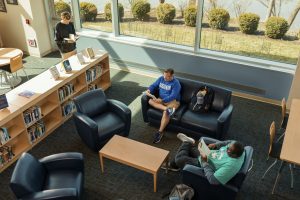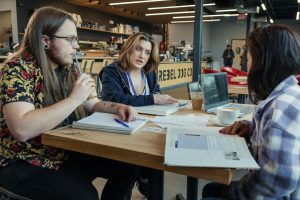By: Jennifer Boylan, MAT, MA, LPC
As an instructor in the Human Services program at Goodwin University, I always aim to help my students succeed — both in the classroom and in their future careers.
Through my participation in the Universal Design for Learning (UDL) Institute, I had the opportunity to reflect on my course, HSR 222: Foundations of Helping and Service Delivery. This process allowed me to take a closer look at what was working well, where my students were facing challenges, and how UDL principles could guide me in making meaningful changes.
What I discovered is that even minor adjustments in teaching strategies, materials, and assessments can open new pathways for learning and empower students to learn to their fullest.
Looking out for learning barriers

Foundations of Helping and Service Delivery (HSR 222) is a Human Services course designed to prepare students for careers in the helping professions. The class introduces learners to evidence-based, person-centered, and strength-based approaches to service delivery — skills that are essential for future human service professionals.
Many components of the course already worked well and aligned with UDL principles. For example, the Interview of a Helping Professional assignment allows students to connect directly with someone in the field, exploring career paths through storytelling and relational learning. This assignment embodies UDL considerations 3.1 and 3.3 because students can connect with and build on their prior knowledge of the field — all while gaining knowledge through storytelling and relational learning.
Furthermore, the course content is available in multiple formats: textbooks, videos, articles, PowerPoints, and external resources. This element aligns with UDL considerations 1.1, 1.2, and 2.5 by empowering learners to take autonomy over how they engage with the material and providing flexible pathways for deeper learning.
However, when assessing the textbook and course design, I noticed that the approaches for human services orientations are at the end of the book. I call this critical event “The Afterthought of Theoretical Orientations.”
This presented a challenge, as the learners would not have the opportunity to fully grasp and align with one or more orientations for their future practice in the helping field. Students struggled to quickly acquire the various approaches and techniques for each orientation within the limited time we have each semester. Consequently, they experienced difficulties when applying different orientations to case studies, as evidenced by class discussions and online discussion boards.
When I considered these issues through the lens of the UDL 3.0 Guidelines, I determined that this presented a significant barrier. There was a lack of applicable opportunities to engage with orientations and case studies throughout the semester. This design issue isolated my students’ ability to engage with relevant, skill-based knowledge to the end of the semester. The learning materials also lacked in-depth resources relating to orientations, limiting their ability to perceive, access, and interact with this course content.
Lastly, when considering learning assessments, there were limited modalities, restricting learners to producing either a paper or a narrated PowerPoint for each assignment. These limitations restricted my students’ abilities to express their knowledge in a creative manner suited to their individual learning styles and preferences.
Designing student-centered solutions

After assessing these learning barriers, I am making adjustments to my teaching. I plan to introduce orientations at the beginning, giving students ample opportunity to grasp the techniques and apply them to multiple and diverse client cases. Doing this will increase engagement, as content will be aligned with the application of skills relevant to learners’ career goals, aligning with UDL Consideration 7.2.
To increase the accessibility of the learning materials, I plan to create an interactive table outlining the orientations. The table will serve as a self-paced learning tool with links to external resources and case studies. By providing this tool, I can enable students to autonomously explore the content from an interactive space, aligning with UDL Consideration 3.3.
To address the barriers in class assessments, I plan to include creative assessment modalities to demonstrate knowledge, such as captioned images, reflective journals, and video or audio presentations of storytelling. My goal is to empower students to use assessment modalities that thoroughly and accurately express their learning, aligning with UDL Consideration 5.1.
Instructional innovation and student success

Reflecting on my experiences with the UDL Institute, I have learned that with creativity and flexibility, it is always possible to find a UDL-aligned solution to a learning barrier. By maximizing the potential of existing tools and drawing inspiration from colleagues, even small instructional adjustments can lead to powerful results for students. I am excited to implement the changes I’ve outlined here and look forward to continuing to refine and expand my approach in the semesters ahead.
I’ve also discovered that creating and applying UDL-aligned strategies not only enhances the student experience but also energizes instructors. There is a unique sense of anticipation in seeing how students respond to new approaches, and that excitement fuels motivation to keep innovating. For me, this journey has reaffirmed that small, intentional changes can spark meaningful growth — for both learners and educators alike.
Ready to become an educational innovator? Learn more about Goodwin’s UDL Institute today!

Jennifer Boylan is an assistant professor and the internship coordinator for Human Services at Goodwin University. She holds a Master of Arts in Teaching (MAT) from Quinnipiac University and a Master of Arts in Clinical Mental Health Counseling from the University of Saint Joseph. She is a licensed professional counselor (LPC) and has additional expertise in the ADA and disability rights in higher education.
Goodwin University is a nonprofit institution of higher education and is accredited by the New England Commission of Higher Education (NECHE), formerly known as the New England Association of Schools and Colleges (NEASC). Goodwin University was founded in 1999, with the goal of serving a diverse student population with career-focused degree programs that lead to strong employment outcomes.

